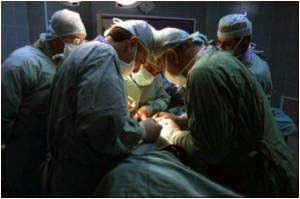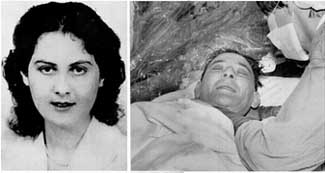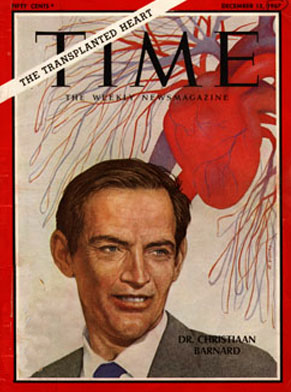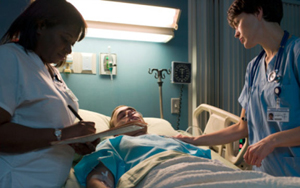 |
Right to Life
Don’t Give Your Vital Organs - Part I
New Concepts of Death to Fit Needs of
Transplant Doctors
Randy Engel
Many readers of this site, I think, are acquainted with my pro-life credentials. I was privileged to have come into the Pro-life Movement at the ground floor in the early 1960s. My initial interest was in federal domestic and foreign population control programs and later eugenic abortion, sex initiation programs in public and parochial schools, human embryo and fetal experimentation, and euthanasia.
In 1972, I founded the U.S. Coalition for Life as an international pro-life research agency and six years later, with the assistance of the Dr. Jerome Lejeune of the University of Paris, I established the International Foundation for Genetic Research, popularly known as the Michael Fund, as the prolife alternative to the March of Dimes. I have written three books dealing with pro-life issues.
Given this background, one would think I should have known the truth about unpaired vital organ transplantation as a form of euthanasia, a form of killing, but the sad truth is that while I should have known, I did not know. And I would have remained in my state of ignorance had it not been for Dr. Paul Byrne, an Ohio neonatologist and co-founder of the Life Guardian Foundation, who removed the scales from my eyes and permitted me to see vital organ transplantation for the evil that it is. (1)
The organ donor industry
Like the abortion industry, the vital organ transplantation industry rests on the utilitarian principle that the end justifies the means. Like the abortion industry, its nexus is hard, cold cash – billions in hard cold cash. The only thing harder and colder that the cash is the hearts of the surgeons and staff who, having come to the knowledge that they must kill a living donor in order to retrieve a healthy organ for a recipient fellow human being, continue to engage in this medical butchery, and rationalize said killing as justifiable on the grounds that that the excised organ will be used to save the life of another living human being.
Pro-lifers need to make vital organ transplantation a key right to life issue because it is a violation of the Natural Moral Law and God's Commandment – thou shalt not kill.
Paired vs. unpaired organ transplants

A paired organ transplant like the kidney, above, is generally permitted |
From the onset, it is important to distinguish between paired and unpaired organ donation. The transplantation of paired organs such as one of two kidneys, a lobe of a liver or a lobe of a lung is generally permitted provided true informed consent is gotten from the donor and that he fully understands that the removal of these organs/organ parts decreases his own bodily functions. But the case of unpaired, that is, single vital organs such as the heart and the liver, is an altogether different matter
By the mid-1960s, following numerous failed attempts at obtaining viable unpaired organs like the heart from fresh cadavers or corpses, it became clear to transplant surgeons that healthy vital organs for transplantation can only be gotten from a living donor – a beating heart can only be obtained from a living human being.
Christian Barnard's dark secret
Enter South African surgeon Christian Barnard who had received part of his post graduate medical studies in the United States at the University of Minnesota. It was here that he first met Dr. Norman Shumway, who did much of the pioneering research leading up to the first human heart transplant. Barnard performed the first kidney transplant in South Africa in October 1967, but his primary interest was cardiac surgery. He wanted to do a human heart transplant.
In November 1967, Barnard found a 54-year-old patient by the name of Louis Washkansky who agreed to participate in the medical experiment as a heart recipient.

The breakthrough: Denise Darvall's living heart was given to Washkansky, right |
One month later, on December 3, 1967, the father of Denise Darvall, a young woman who was seriously injured in a car accident that killed her mother, gave his permission to have his daughter's heart excised and transplanted to Mr. Washkansky. That same day, the world's first human heart transplant operation took place. Bernard was assisted by his brother, Marius. The operation lasted 9 hours and employed a team of 30 medical personnel.
The immediate problem facing Barnard was that, although Denise's brain was damaged, her heart was healthy and beating, indicating she was still alive by traditional whole body standards. So what would make her heart stop so that it could be legally excised? Barnard later told reporters that he had waited for her heart to stop naturally before cutting it out, but this was a lie. It was not until 40 years later that the public learned the truth.
At Marius's urging, after his brother had cleaved open the chest cavity, Christian had injected a concentrated dose of potassium to paralyze Denise's heart, thus rendering her "technically" dead. (2) Everything had already been prepared so Bernard proceeded to quickly cut the major vessels, cool the heart and sew it into the recipient. Denise was alive before her heart was excised. She was truly dead after it was cut out of her body.
Three days after the Barnard murder, not to be outdone by a doctor in South Africa, Dr. Adrian Kantrowitz, a surgeon at Maimonides Medical Center in Brooklyn cut a beating heart out of a live 3-day-old baby and transplanted into an 18-day-old baby with heart disease. At the end of the day both babies were dead.
A redefinition of death
The controversy following the Kantrowitz killings was instrumental in the formation of the Harvard Medical School ad hoc Committee to study "brain death" as the new criteria for death.
The obvious conundrum facing transplantation surgeons was that organs taken from cadavers do not recover from the period of ischemia (loss of blood supply to organs) following true death. After circulation and respiration has stopped, within 4 to 5 minutes the heart and liver are not suitable for transplantation. For kidneys the time is about 30 minutes.

Dr. Barnard took the heart from a living person
|
Equally clear was the realization that in order to continue unpaired vital organ transplantation it would be necessary to redefine death, that is, to establish a new criterion for death that would legally permit the extraction of vital organs from living human beings. Such a redefinition would permit transplantation surgeons to kill with legal immunity.
In August 1968, the Journal of the American Medical Association published "A Definition of Irreversible Coma: Report of the Ad Hoc Committee of the Harvard Medical School to Examine the Definition of Brain Death." (3) No authors were listed. (4)
The Harvard Committee cited two reasons for establishing "brain death" as the new criteria for death. The first was the problems surrounding the use of resuscitation and other supportive measures to extend the life of severely injured persons. The second reason was "obsolete criteria for the definition of death can lead to controversy in obtaining organs for transplantation."
It should also be noted that the criteria of "brain death" did not originate or develop by way of application of the scientific method of observation and hypothesis followed by verification. The Committee presented no substantiating data either from scientific research or case studies of individual patients. The Committee did not determine if irreversible coma was an appropriate criterion for death. Rather, its mission was to see that it was established as a new criterion for death. In short, the report was made to fit the already arrived at conclusions.
The myth of brain death
Biologically speaking, the body is composed of cells, tissues, organs and eleven systems, including three major vital systems. No one organ or system controls all other organs and systems. Interdependent functioning of organs and systems maintains unity, homeostasis, immune defenses, growth, healing and exchange with environment, e.g., oxygen and carbon dioxide. It might be well to recall at his point that that the human embryo does not develop a brain until he is 6 weeks old, yet he is a living human being from the moment of conception.
We all recognize the signs of life in a human being including temperature, pulse, blood pressure, respiration, and reflexes. We also recognize the signs of death including the lack of breathing, heartbeat, pulse and blood pressure. Once the soul has departed from the body, what remains is a corpse - empty, cold, blue, rigid and unresponsive to all stimuli. Ventilation will not restore respiration in a corpse. A pacemaker can send a signal, but it cannot initiate the heartbeat in the corpse. Healing never occurs in a patient that is truly dead. Certitude is the general putrefaction of the body.
Using these traditional criteria for death, it is clear that the "brain-dead" patient is truly alive. His body is warm and flexible. He has a beating heart, normal color, temperature, and blood pressure. Most functions continue, including digestion, excretion, and maintenance of fluid balance with normal urine output. He is given intravenous feedings, blood transfusions, antibiotics, and other medications necessary to keep him in tip-top shape for the transplantation operation. There will often be a response to surgical incisions. Given a long enough period of observation, he will show signs of healing and growth. If a child, he will begin to go through the stages of puberty.

A potential donor is tested and pronounced 'brain dead': a new profit for the hospital |
Insurance companies cover the ICU or ER costs for the "brain dead" patient as well as all his medical expenses as they do for other living patients. Any costs involving the transfer of an organ donor to another hospital is covered by insurance. Would they do this for a corpse?
Shortly after the Harvard Committee report was published in JAMA, "brain death" was adopted as the new standard of death in most hospitals, including Catholic hospitals, in the U.S. By 1978, 30 disparate sets of criteria for "brain death" were published - each set of criteria tending to be less strict than previous sets. The liberal mass media began to adjust its language to accommodate the new "reality" by referring to a "brain dead" donor as a "beating heart cadaver," "a ventilated corpse," or the "living dead" implying a person could be alive and dead at the same time. (5)
One of these new definitions of death is "cardiac death" which is used when a potential organ donor does not meet the criteria for "brain death," but he has sustained certain injuries or has an illness suggesting that death will soon occur. Under the cardiac criteria, a patient can be declared dead on the basis of "irreversible (impossible to reverse) cessation of cardiac function," and his organs harvested for transplantation.
The unanswered question is: How is it possible to declare that the damage to the donor's heart was irreversible, meaning impossible to reverse and that the heart had lost all its functions, and then have it work perfectly well after it has been transplanted to a recipient? The answer points in the direction of checkbook euthanasia. Transplantation programs are highly desirable to hospitals as they are high profit programs. Giving vigorous CPR to the "living dead" is not as cost effective as excising and selling his organs.
1. See http://lifeguardianfoundation.org/missionstatement.html.
2. Donald McRae, Every Second Counts: The Race to Transplant the First Human Heart, New York, Putnam, 2006, p. 335.
3. See http://jama.ama-assn.org/cgi/content/summary/205/6/337.
4. The Ad Hoc Committee included Henry K. Beecher, MD, chairman; Raymond D. Adams, MD; A. Clifford Barger, MD; William J. Curran, LLM, SMHyg; Derek Denny-Brown, MD; Dana L. Farnsworth, MD; Jordi Folch-Pi, MD; Everett I. Mendelsohn, PhD; John P. Merrill, MD; Joseph Murray, MD; Ralph Potter, ThD; Robert Schwab, MD; and William Sweet, MD.
5. In The City of God, Book XIII, Chap. 11, St Augustine addresses the question — Can one be both living and dead at the same time? He replies in the negative, that there is no third state — one is either alive or dead. A man may be dying but he is still alive until he is dead and his soul is separated from his body.
Read part 2 of this article:
Well Prepared Propaganda to Get Organs from the Victims’ Families
Randy Engel is Director of U.S. Coalition for Life
This article was first published in
Catholic Family News and in Renew America

Posted April 27, 2010

Related Topics of Interest
 Terri Schiavo and the Fight for Life Terri Schiavo and the Fight for Life
 The King and the Socialist Abortion Law The King and the Socialist Abortion Law
 The Holy See Abandons Its Pro-Life Position The Holy See Abandons Its Pro-Life Position
 'Nine Frozen Little Ones Hanging out' 'Nine Frozen Little Ones Hanging out'
 Ratzinger Soft on Abortionists Ratzinger Soft on Abortionists
 Ratzinger Flip Flops on Communion for Pro-Abortion Politicians Ratzinger Flip Flops on Communion for Pro-Abortion Politicians

Related Works of Interest
|
|
Right to Life | Cultural | Hot Topics | Home | Books | CDs | Search | Contact Us | Donate

© 2002- Tradition in Action, Inc. All Rights Reserved
|
 |

|